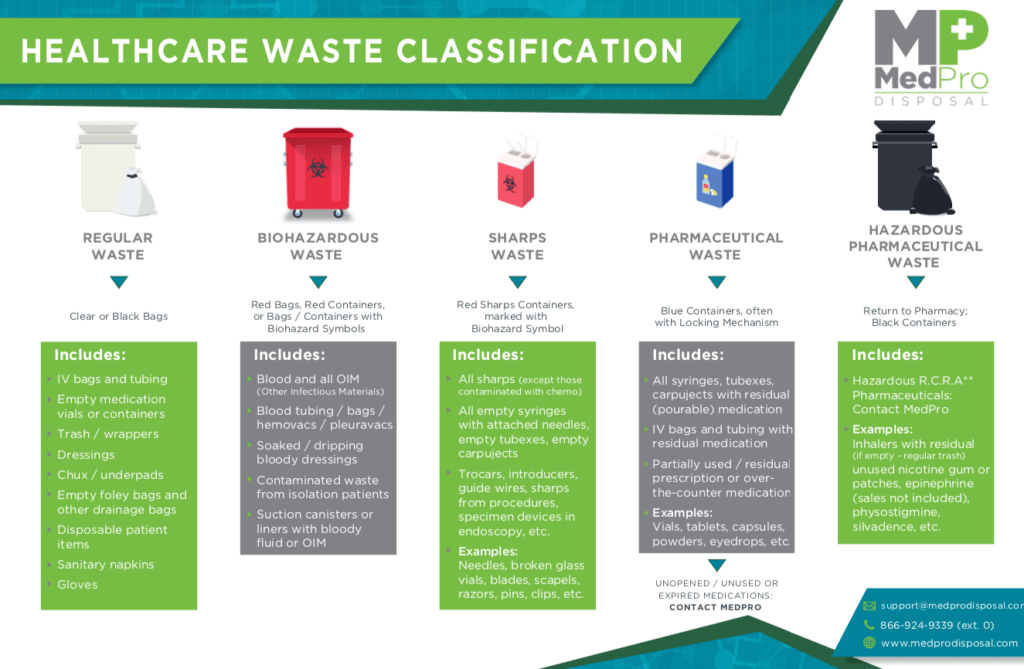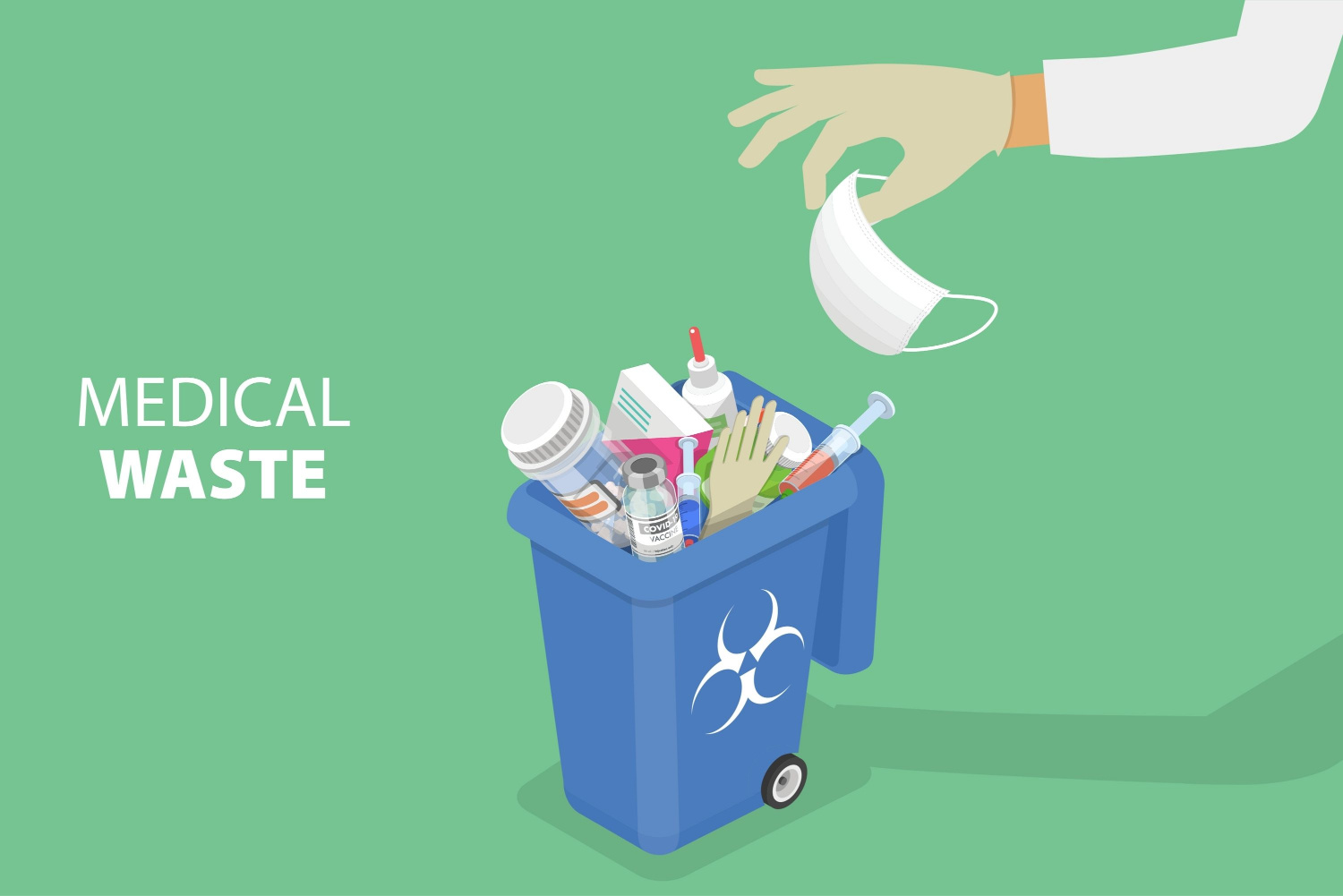Your Ally in Medical Waste Removal: Specialist Service with Environmental Treatment
Conformity and Rules for Medical Waste Disposal
Conformity and guidelines for medical waste disposal play an important function in making certain the safety and security and wellness of both healthcare specialists and the general public. Proper management of clinical waste is important to protect against the spread of infections, secure the setting, and maintain public health. This needs adherence to particular guidelines and procedures set forth by regulatory firms and bodies. These guidelines include numerous elements, including the category and partition of medical waste, proper storage and dealing with treatments, as well as transport and disposal techniques. By complying with these guidelines, health care centers can lessen the danger of contamination and potential damage to individuals and the atmosphere. This post will discover the significance of conformity and give an introduction of the crucial regulations regulating medical waste disposal.
Significance of Conformity
The importance of compliance with laws for clinical waste disposal can not be overstated. Correct disposal of medical waste is crucial for making certain the safety and security and well-being of health care workers, patients, and the public. Medical waste, that includes products such as made use of needles, infected handwear covers, and biomedical waste, can posture serious wellness dangers if not handled and dealt with appropriately.
Compliance with regulations guarantees that clinical waste is managed in a manner that decreases the possibility for direct exposure to damaging substances and contagious illness - medical waste removal. It assists avoid the spread of infections, such as HIV, hepatitis B and C, and other bloodborne virus. Conformity additionally plays an essential function in shielding the atmosphere by avoiding contamination of water sources, dirt, and air
Failure to follow laws can cause extreme consequences for healthcare facilities, consisting of fines, lawsuit, and damage to their online reputation. In addition, non-compliance may compromise the health and wellness of health care employees, clients, and the area.
Conformity with guidelines for medical garbage disposal requires adherence to certain standards and protocols. These might consist of proper partition, packaging, labeling, and storage of medical waste. It likewise involves utilizing approved disposal methods, such as incineration, landfilling, or autoclaving, depending on the sort of waste.
Regulatory Agencies and Bodies
Regulatory companies and bodies play a crucial duty in overseeing conformity with policies for clinical garbage disposal. These organizations are in charge of establishing methods, standards, and criteria to guarantee the correct and secure handling of medical waste. They check and apply conformity to protect public wellness and the environment.
One of one of the most noticeable regulative companies in the United States is the Environmental Defense Agency (EPA) The EPA is in charge of controling the storage space, transportation, treatment, and disposal of clinical waste. They develop guidelines for waste generators, carriers, and treatment facilities to adhere to, making sure that all essential preventative measures are required to prevent the spread of diseases and contamination.
Another essential regulatory body is the Occupational Safety And Security and Health And Wellness Administration (OSHA) OSHA sets policies and criteria to protect workers from work-related threats, consisting of those relevant to medical waste. WasteX Medical Waste Disposal. They provide guidelines for the risk-free handling and disposal of clinical waste to safeguard staff members in medical care facilities
In addition to these federal companies, private states also have their own regulative bodies that manage clinical garbage disposal. These companies may have their very own details guidelines and requirements that need to be followed.

Category and Segregation of Medical Waste
To ensure correct monitoring of clinical waste, it is necessary to identify and segregate it according to established protocols and guidelines. medical waste disposal. Classification and segregation play a crucial role in minimizing the threat of infection, safeguarding the setting, and ensuring the safety and security of health care employees and the basic public
Medical waste is classified into various categories based on its prospective hazard degree. These categories include contagious waste, pathological waste, sharps waste, pharmaceutical waste, chemical waste, and contaminated waste. Each category needs certain handling, disposal, transportation, and storage approaches to decrease the threat of exposure and contamination.
Segregation of medical waste entails separating different types of waste at the source. This procedure ensures that waste with different risk degrees is not combined, reducing the potential for cross-contamination and making disposal treatments a lot more reliable. Appropriate partition is attained with making use of color-coded containers and labels, which assist medical care employees and waste administration workers deal with each type and identify of waste properly.
In enhancement to category and partition, healthcare centers must also adhere to regional, state, and government guidelines concerning clinical waste administration. These guidelines lay out certain needs for storage, transportation, therapy, and final disposal of medical waste, making sure conformity and preserving public health and safety and security.
Correct Storage Space and Managing Procedures
Correct storage space and managing procedures play a critical duty in ensuring the compliant and secure management of clinical waste. Clinical waste, which consists of things such as made use of syringes, infected handwear covers, and ended medicines, can position severe wellness and environmental risks if not handled correctly. It is important for medical click site care facilities and various other generators of clinical waste to execute stringent storage and managing methods.
To begin with, medical waste needs to be stored in durable, watertight containers that are specifically developed for this purpose. These containers must be identified with the global biohazard sign and the words "clinical waste" to plainly suggest the materials. Furthermore, the containers need to be maintained firmly near prevent any potential leak or splilling.
Furthermore, it is essential to set apart different kinds of clinical waste to stop cross-contamination. Sharps, such as scalpels and needles, ought to be kept in puncture-resistant containers to decrease the risk of injuries - WasteX Medical Waste Disposal. Chemical waste, such as disinfectants and solvents, must be kept independently from various other kinds of clinical waste to stop chemical reactions or dangerous exposures

Transport and Disposal Approaches
Healthcare centers need to make sure the safe transport and correct disposal of their medical waste to abide by laws and secure public health and wellness. Transportation and disposal approaches play a crucial duty in stopping the spread of transmittable illness and reducing the ecological effect of medical waste.
To move medical waste, healthcare centers should make use of puncture-resistant and watertight containers that are identified with the biohazard symbol. These containers ought to be firmly secured to prevent any kind of leakage throughout transportation. In addition, healthcare centers should develop protocols for the transport procedure, including making use of trained employees and specialized vehicles.
Once the clinical waste reaches the disposal center, it goes through numerous approaches of therapy - WasteX Medical Waste Disposal. One typical method is incineration, which involves shedding the waste at high temperature levels to ruin pathogens and decrease the volume of waste.
It is important for medical care centers to collaborate with licensed and permitted waste administration business to make sure correct transport and disposal of clinical waste. These business have the proficiency and resources to handle medical waste safely and in compliance with regulations.
Conclusion
In verdict, compliance with laws for medical waste disposal is of utmost importance to make certain public health and wellness and safety and security. Generally, adherence to conformity and guidelines is required to properly handle clinical waste.
Medical waste, which consists of items such as utilized needles, contaminated handwear covers, and biomedical waste, can pose severe health dangers if not handled and disposed of appropriately.
These categories consist of infectious waste, pathological waste, sharps waste, pharmaceutical waste, chemical waste, and contaminated waste.Partition of medical waste entails separating different kinds of waste at the resource. Proper partition is attained through the use of color-coded containers and tags, which help health care employees and waste monitoring personnel determine and take care of each type of waste correctly.
Chemical waste, such as disinfectants and solvents, need to be stored individually from various other types of medical waste to stop harmful direct exposures or chemical responses.